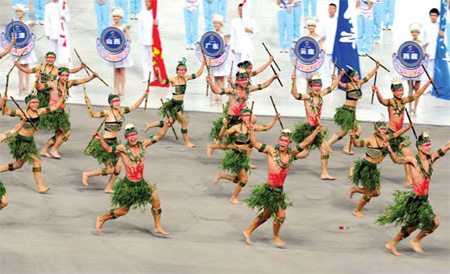Spicy welcome to the southwest
Updated: 2011-09-10 08:09
By Tiffany Tan (China Daily)
|
|||||||||||
|
Performance based on ancient ethnic rites. Zhao Hui / for China Daily |

That big packet of chili sauce with the picture of a Miao woman smiling broadly, which came with my meal on the flight to Guizhou, should have tipped me off to the mealtime welcome I'd get in this southern province -- hot and spicy, with a this-is-me, take-it-or-leave-it attitude.
My real initiation came in the form of suantangyu, a mouthwatering Miao dish and apparently its most famous. It contains pieces of fish, or the whole animal (sometimes still wriggling), dumped into a pot of orangey-red liquid. And, true to its name, it was indeed sour, but someone had carelessly left out the more crucial part, that is "spicy".
I couldn't be sure about what it was that left me gasping, the soup - made with tomatoes, rice, water and fragrant mountain peppers - or the dip -- a mixture of chili sauce, tofu and spring onions.
"Oh, just so-so," commented Zhang Yu, a 21-year-old intern at our bureau in Guiyang, the provincial capital, when I asked whether she also found the dish intolerably hot. If only she knew: the last time I admitted defeat to a spicy dish was two years ago, in a struggle with a tasty "medium hot" Chongqing hot pot.
The Miao rice wine that traditionally comes with the suantangyu wasn't much help for my burning mouth. The sweet tasting drink contains 17 percent alcohol, and obviously wasn't designed for liquor lightweights like me.
The dessert we got at the Hequn Lu night market was a much better antidote. The bingfen, jelly in iced pineapple juice, was being sold alongside other popular snacks such as siwawa, a sort of do-it-yourself spring roll, and lian'ai tofu (tofu in love), or grilled tofu stuffed with chopped radishes, green onions and spices.
Nearby, in some glass cabinets I found more interesting offerings that were begging to go with beer: pig's kidneys, tails and ears; rooster's comb; chicken feet; and dog meat. The biggest demand for dog in Guizhou supposedly comes in winter since the meat is known to help heat up the body. The young people I've met so far say they don't like the taste.
Guiyang was made for night owls. In addition to the food market on Hequn Lu, there are others on Qingyun Lu and Shaanxi Lu, with hundreds of stalls open from 7 pm till 4 am, every day of the week.
I was curious. "Who on earth comes here in the wee hours of the morning, on weekdays?" I asked one of the vendors. "Don't they have to go to work the following day?"
She gave me a puzzled look, clearly finding the question odd.
Maybe what the locals say about themselves is true: They're some of the most laid-back Chinese around, who like to take their time with food and drink. Obviously, and at any time of the day or night.
(China Daily 09/10/2011 page10)
